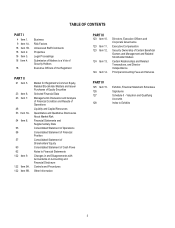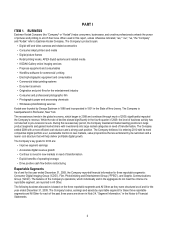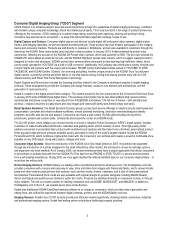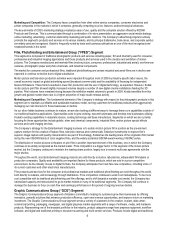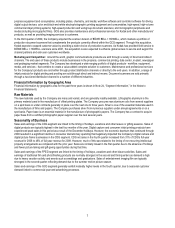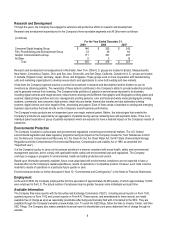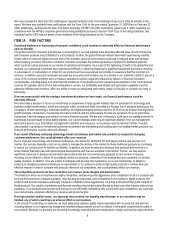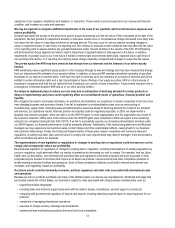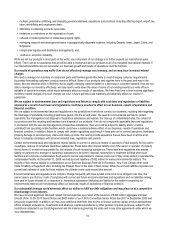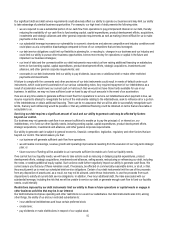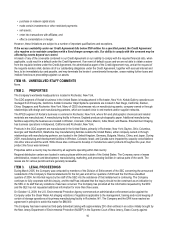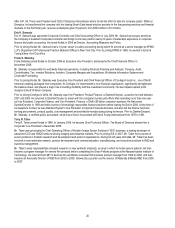Kodak 2009 Annual Report Download - page 15
Download and view the complete annual report
Please find page 15 of the 2009 Kodak annual report below. You can navigate through the pages in the report by either clicking on the pages listed below, or by using the keyword search tool below to find specific information within the annual report. 13
operations of our suppliers, distributors and resellers, or customers. These events could seriously harm our revenue and financial
condition, and increase our costs and expenses.
We may be required to recognize additional impairments in the value of our goodwill, which would increase expenses and
reduce profitability.
Goodwill represents the excess of the amount we paid to acquire businesses over the fair value of their net assets at the date of the
acquisition. We test goodwill for impairment annually or whenever events occur or circumstances change that would more likely than
not reduce the fair value of a reporting unit below its carrying amount. This may occur for various reasons including changes in
actual or expected income or cash flows of a reporting unit. We continue to evaluate current conditions that may affect the fair value
of our reporting units to assess whether any goodwill impairment exists. Secular declines in the results of the Film, Photofinishing
and Entertainment Group segment are likely to lead to impairment of goodwill related to that segment in the future. In addition,
impairments of goodwill could occur in the future if market or interest rate environments deteriorate, expected future cash flows of
our reporting units decline, or if reporting unit carrying values change materially compared with changes in respective fair values.
The private equity firm KKR may have interests that diverge from our interests and the interests of our other security
holders.
KKR beneficially owns a significant equity position in the Company through its warrant holdings and may have interests that diverge
from our interests and the interests of our security holders. In addition, so long as KKR maintains beneficial ownership of specified
thresholds of our shares of common stock, it will have the right to nominate up to two members of our board of directors and will be
entitled to certain information rights and a right to participate in future offerings of our equity securities. KKR is in the business of
investing in companies and they are not restricted from investing in our current or future competitors. Future events may give rise to
a divergence of interests between KKR and us or our other security holders.
Our failure to implement plans to reduce our cost structure in anticipation of declining demand for certain products or
delays in implementing such plans could negatively affect our consolidated results of operations, financial position and
liquidity.
We recognize the need to continually rationalize our workforce and streamline our operations to remain competitive in the face of an
ever-changing business and economic climate. If we fail to implement cost rationalization plans such as restructuring of
manufacturing, supply chain, marketing sales and administrative resources ahead of declining demand for certain of our products
and services, our operations results, financial position and liquidity could be negatively impacted. In 2009, we implemented a
targeted cost reduction program, which we refer to as the 2009 Program, to more appropriately size the organization as a result of
the economic downturn. While most of the actions under the 2009 Program were completed in 2009, we expect some remaining
actions to be completed during the first half of 2010. If we fail to successfully execute our remaining rationalization activities under
our 2009 Program, our financial performance could be adversely affected. Additionally, if the restructuring plans are not effectively
managed, we may experience lost customer sales, product delays and other unanticipated effects, causing harm to our business
and customer relationships. Finally, the timing and implementation of these plans require compliance with numerous laws and
regulations, including local labor laws, and the failure to comply with such requirements may result in damages, fines and penalties
which could adversely affect our business.
The implementation of new legislation or regulations or changes in existing laws or regulations could increase our cost to
comply and consequently reduce our profitability.
New business legislation or regulations or changes to existing laws or regulation, including interpretations of existing regulations by
courts or regulators, could adversely affect our results of operations by increasing our cost to comply. For example, new tax, labor,
health care, product safety, environmental and securities laws and regulations have been proposed and such proposals or other
proposals may be enacted in the future that require us to adopt new policies, internal controls and other compliance practices or
modify existing production facilities and operations. Each of these compliance initiatives could lead to internal and external cost
increases, and negatively impact our profitability.
Our future results could be harmed by economic, political, regulatory and other risks associated with international sales
and operations.
Because we sell our products worldwide and many of the facilities where our devices are manufactured, distributed and supported
are located outside the United States, our business is subject to risks associated with doing business internationally, such as:
• supporting multiple languages;
• recruiting sales and technical support personnel with the skills to design, manufacture, sell and support our products;
• complying with governmental regulation of imports and exports, including obtaining required import or export approval for our
products;
• complexity of managing international operations;
• exposure to foreign currency exchange rate fluctuations;
• commercial laws and business practices that may favor local competition;


